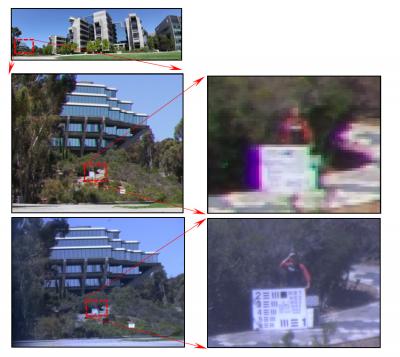[dropcap style=”font-size:100px; color:#992211;”]A[/dropcap]ll that clarity and resolution. And it’ll still end up getting used for sepia-tinted Instagram selfies.
To capture all the details of a crime scene, you might take many photos at close range. To get the whole scene at once, you could use a wide-angle or fisheye lens; but without an especially large lens you would be sacrificing the fine resolution that would help you catch that partial footprint you might otherwise have missed. Now a new type of miniature camera system promises to give users a big picture view without sacrificing high-resolution. Researchers from the University of California, San Diego will describe their novel device at The Optical Society’s (OSA) Annual Meeting, Frontiers in Optics (FiO) 2013, taking place Oct. 6-10 in Orlando, Fla.
The new imager achieves the optical performance of a full-size wide-angle lens in a device less than one-tenth of the volume. It has a 100x range of focus, meaning it can image anything between half a meter and 500 meters away, and it has 0.2-milliradian resolution, equivalent to 20/10 human vision. Such a system could enable high-resolution imaging in micro-unmanned aerial vehicles, or smartphone photos more comparable to those from a full size single-lens reflex (SLR) camera, the researchers say.
“The major commercial application may be compact wide-angle imagers with so much resolution that they’ll provide wide-field pan and ‘zoom’ imaging with no moving parts,” said project leader Joseph Ford, a professor in the Jacobs School of Engineering at UC San Diego.
To engineer the new system, researchers turned to monocentric lenses made of concentric glass shells, which are perfectly round like glass marbles. Their symmetry allows them to produce wide-angle images with high resolution and hardly any of the geometrical distortions common to fisheye lenses.
 [This is the advantage of a monocentric lens. Top: This image was captured with a conventional wide-angle lens, a Canon EOS 5D Mark III DSLR with a 12mm focal length. Middle: An inset of the image above. A close-up (right) of the man holding the board shows that this picture, taken with a conventional wide-angle camera with 12mm focal length, does not have very high resolution. Bottom: An image taken with a monocentric lens relayed onto a high-magnification digital microscope. This system did not include the fiber coupling developed by the researchers for their prototype camera, but the clarity of the detail shows the potential of using monocentric lenses to take images with both high resolution and a wide field of view. Image: UCSD Jacobs School of Engineering]
[This is the advantage of a monocentric lens. Top: This image was captured with a conventional wide-angle lens, a Canon EOS 5D Mark III DSLR with a 12mm focal length. Middle: An inset of the image above. A close-up (right) of the man holding the board shows that this picture, taken with a conventional wide-angle camera with 12mm focal length, does not have very high resolution. Bottom: An image taken with a monocentric lens relayed onto a high-magnification digital microscope. This system did not include the fiber coupling developed by the researchers for their prototype camera, but the clarity of the detail shows the potential of using monocentric lenses to take images with both high resolution and a wide field of view. Image: UCSD Jacobs School of Engineering]
Though researchers have tried to use monocentric lenses for high-resolution wide-angle viewing in the past, they ran into two main problems. First, they had trouble conveying the rich information collected by the lens to electronic sensors that could record the image. Ford’s team addressed this problem using a dense array of glass optical fiber bundles that are polished to a concave curve on one side so that they perfectly align with the lens’ surface.
A second problem involved focusing. Researchers had expected that the fibers would have to move in and out to focus to different distances, or the lens would only provide perfect focus for a single direction. Ford’s team showed that the changes in axial distance between fibers and lens did not distort the image.
In his talk, Ford will describe a prototype system with a monocentric lens with 12 mm focal length, making it ultra-wide-angle, and a single imaging fiber bundle connected to a 5-megapixel image sensor. Ford and his colleagues at UC San Diego and Distant Focus Corporation are currently assembling a 30-megapixel prototype and plan to go even bigger in the future. “Next year, we’ll build an 85-megapixel imager with a 120-degree field of view, more than a dozen sensors, and an F/2 lens – all in a volume ‘roughly the size of a walnut,'” he said.
The project is part of the DARPA-funded “SCENICC” (Soldier Centric Imaging via Computational Cameras) program.
Source: The Optical SocietyLights Photo: Sean Keenan

Some of the news that we find inspiring, diverting, wrong or so very right.


















